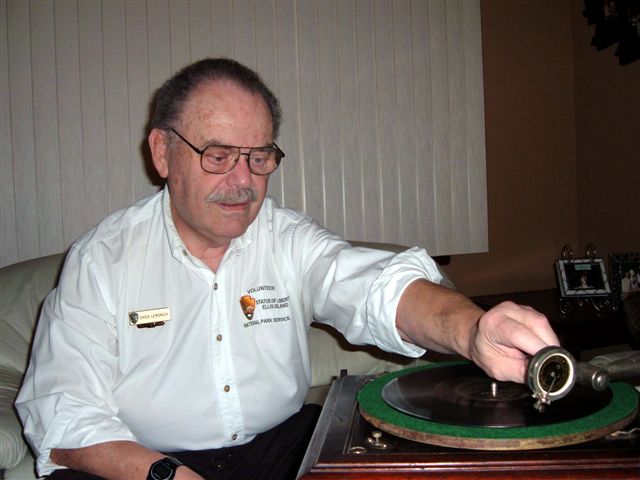English Acquisition by Immigrants (1880-1940): The Confrontation as Reflected in Early Sound Recordings Eric Byron
Most immigrants during the peak immigration years 1880 through 1924 arrived in America without being able to understand or speak English. These people entered a land where, unlike many of the places from which they came, one language, English, predominated, and everyone was expected to learn it as quickly as possible. For the vast majority of new arrivals, success in America meant achieving at least a rudimentary understanding and speaking proficiency in the new language. Fortunately for those of us interested in the dynamics of ethnic interaction, the acquisition, use, and misuse of English played a major role in the tens of thousands of commercial sound recordings that were made by and for immigrants in the United States during these years. This work will focus mainly on just one aspect of the dynamic: the deliberate use of English on primarily non-English records to illustrate the frustrations, anxieties and humor immigrants experienced in their acquisition of English. The data for the paper comes from the Ellis Island Discography Project database. Ellis Island, part of the Statue of Liberty National Monument, is administered by the National Park Service (NPS).
Brief History of Sound Recordings
Recording companies began to produce commercial sound recordings for the mainstream American public during the 1890s. These recordings were produced in a variety of formats, including skit and song, drama and comedy. Initially, the companies restricted most of the works to one side of a record, but as years passed a few of the skits were expanded. To better understand the influence of the phonograph, it should be remembered that radio did not come into its own until well into the 1920s. Few could even imagine the concept of television.
Realizing the potential of the ethnic market, companies gradually increased the number of recordings for immigrant groups. By the early 1920s, Victor and Columbia, the two largest companies, offered more ethnic recordings in their catalogues than non-ethnic ones (Greene 1992, 77). Between 1900 and 1950, American companies produced "at least 30,000 different 78-rpm records aimed at foreign-born communities"(Kenny 1999, 67). A significant portion, most likely the majority, dealt with everyday issues, including all the difficulties associated with being in this strange land with strange people.
Ellis Island Immigration Project
Anticipating the wealth of information that might be found on this type of recording, staff and volunteers in the Museum Division of the Ellis Island Immigration Museum began working on a cataloguing project in 1997. Volunteers, under the direction of NPS staff, have been and remain the driving force behind the effort. To date, information about and examples of this early era of sound recordings have been compiled from approximately a hundred different sources, including books, on-line resources, and private collections. As the Coordinator of the Ellis Island Discography Project, the author has collected more than 1,200 records and also provided his recording equipment and a vintage windup phonograph. Volunteers have transcribed and translated recordings and entered pertinent material into a ProCite database, creating an opportunity to understand cultural patterns beyond the content of individual recordings.
Scope of Project
Presently, the database has more than 7,800 entries [1] and entries continue to be added as they become available. When complete, each entry should contain details that summarize the sound recording, including the name of the recording, bibliographical facts about the author and performer, the catalogue number, the matrix number (the number assigned to each master recording), the ethnic/racial focus, when the piece was recorded, when it was released, key words, summarizing phrases, and where a copy of the recording might be located. Transcriptions, translations where necessary, and pertinent anecdotal description are often also included. Using a windup phonograph, sound recording equipment and sound-enhancing computer software, CDs are made of the original records. The finished product goes to those people who have volunteered to transcribe and translate.
Volunteer Charles Lemonick  deserves special recognition for realizing the potential of ProCite, a bibliographic retrieval program that permits researchers to access not only specific words, but also conceptual units. Lemonick's contributions include devising a customized worksheet for gathering facts, entering all the data into ProCite, and making numerous recommendations about how information should be ordered and where it might be located. Due to his efforts, the elements that make up recordings can be bundled together, separated, compared, and contrasted, revealing interesting relationships.
deserves special recognition for realizing the potential of ProCite, a bibliographic retrieval program that permits researchers to access not only specific words, but also conceptual units. Lemonick's contributions include devising a customized worksheet for gathering facts, entering all the data into ProCite, and making numerous recommendations about how information should be ordered and where it might be located. Due to his efforts, the elements that make up recordings can be bundled together, separated, compared, and contrasted, revealing interesting relationships.
Image: Charles Lemonick, who has donated approximately 9,000 hours to the discography project.
Eric Byron is the Coordinator of the Ellis Island Discography Project at the Ellis Island Immigration Museum of the National Park Service. He can be reached at (212) 363-3206 ext. 153.
